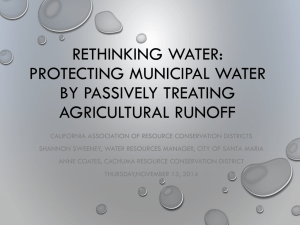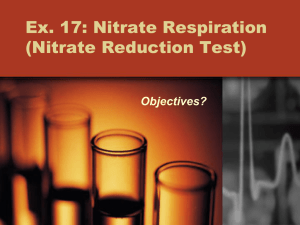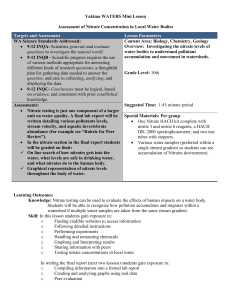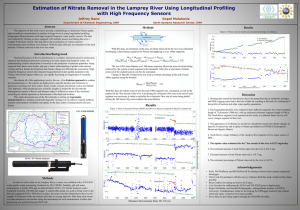Mike Nugent Michael A. Kamrin Institute for Environmental
advertisement
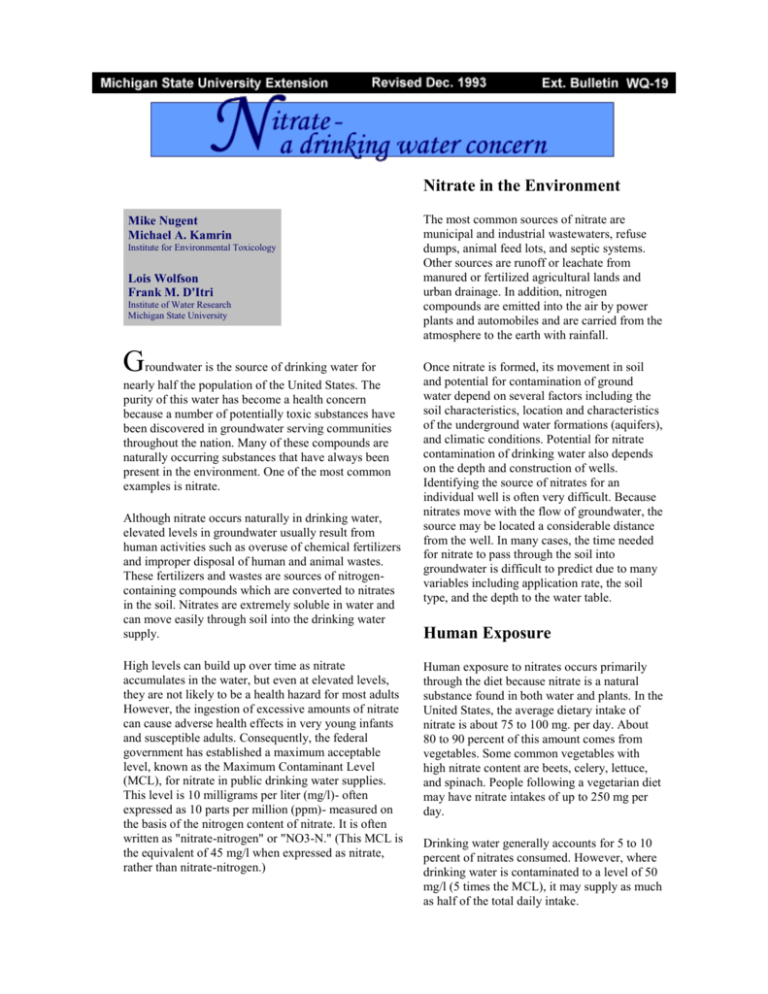
Nitrate in the Environment Mike Nugent Michael A. Kamrin Institute for Environmental Toxicology Lois Wolfson Frank M. D'Itri Institute of Water Research Michigan State University Groundwater is the source of drinking water for nearly half the population of the United States. The purity of this water has become a health concern because a number of potentially toxic substances have been discovered in groundwater serving communities throughout the nation. Many of these compounds are naturally occurring substances that have always been present in the environment. One of the most common examples is nitrate. Although nitrate occurs naturally in drinking water, elevated levels in groundwater usually result from human activities such as overuse of chemical fertilizers and improper disposal of human and animal wastes. These fertilizers and wastes are sources of nitrogencontaining compounds which are converted to nitrates in the soil. Nitrates are extremely soluble in water and can move easily through soil into the drinking water supply. High levels can build up over time as nitrate accumulates in the water, but even at elevated levels, they are not likely to be a health hazard for most adults However, the ingestion of excessive amounts of nitrate can cause adverse health effects in very young infants and susceptible adults. Consequently, the federal government has established a maximum acceptable level, known as the Maximum Contaminant Level (MCL), for nitrate in public drinking water supplies. This level is 10 milligrams per liter (mg/l)- often expressed as 10 parts per million (ppm)- measured on the basis of the nitrogen content of nitrate. It is often written as "nitrate-nitrogen" or "NO3-N." (This MCL is the equivalent of 45 mg/l when expressed as nitrate, rather than nitrate-nitrogen.) The most common sources of nitrate are municipal and industrial wastewaters, refuse dumps, animal feed lots, and septic systems. Other sources are runoff or leachate from manured or fertilized agricultural lands and urban drainage. In addition, nitrogen compounds are emitted into the air by power plants and automobiles and are carried from the atmosphere to the earth with rainfall. Once nitrate is formed, its movement in soil and potential for contamination of ground water depend on several factors including the soil characteristics, location and characteristics of the underground water formations (aquifers), and climatic conditions. Potential for nitrate contamination of drinking water also depends on the depth and construction of wells. Identifying the source of nitrates for an individual well is often very difficult. Because nitrates move with the flow of groundwater, the source may be located a considerable distance from the well. In many cases, the time needed for nitrate to pass through the soil into groundwater is difficult to predict due to many variables including application rate, the soil type, and the depth to the water table. Human Exposure Human exposure to nitrates occurs primarily through the diet because nitrate is a natural substance found in both water and plants. In the United States, the average dietary intake of nitrate is about 75 to 100 mg. per day. About 80 to 90 percent of this amount comes from vegetables. Some common vegetables with high nitrate content are beets, celery, lettuce, and spinach. People following a vegetarian diet may have nitrate intakes of up to 250 mg per day. Drinking water generally accounts for 5 to 10 percent of nitrates consumed. However, where drinking water is contaminated to a level of 50 mg/l (5 times the MCL), it may supply as much as half of the total daily intake. Page 2 When nitrate is ingested, bacteria in the mouth convert the nitrate in saliva into nitrite, producing an average of about 10 mg./day. Nitrite, itself, can be ingested by consuming cured meats such as bacon and luncheon meats. However, since ingested nitrate is the major source of nitrite in the body, high levels of nitrate in drinking water are generally responsible for high levels of nitrite in the body. Nitrate intake depends on a variety of factors, including diet, and amount and quality of water consumed. Genetic factors also lead to different rates of conversion of nitrate to nitrite. As a result, people show great variability in nitrate and nitrite levels in their bodies. These variations make prediction of adverse health effects from nitrate or nitrite a difficult task for public health professionals. Health Effects The most significant health effect associated with nitrate ingestion is methemoglobinemia in infants under six months of age. This condition results from the presence of high nitrite levels in the blood. Methemoglobinemia occurs when hemoglobin, the oxygen-carrying component of blood, is converted by nitrite to methemoglobin, which does not carry oxygen through the body as efficiently. As a result, vital tissues, including the brain, receive less oxygen than they need. Untreated, severe methemoglobinemia can result in brain damage and even death. Infants in the first six months of life are particularly susceptible to nitrite-induced methemoglobinemia for several reasons. First, since the stomach acid of an infant is not as strong as in older children and adults, bacteria which readily convert nitrate to nitrite are more numerous. This results in higher nitrite levels in blood. Second, hemoglobin in infants is more readily converted to methemoglobin than is an adult's hemoglobin. Third, methemoglobin in infant blood cannot be changed back to hemoglobin as normally occurs in adults. Finally, infants have a higher intake of water for their weight than adults, so consequently, they ingest a relatively higher amount of nitrate. In addition to small infants, some adults may be susceptible to the development of nitrite- induced methemoglobinemia. These include pregnant women with a particular enzyme deficiency [G6PD] deficiency), adults with reduced stomach acidity, and those with a deficiency in the enzyme needed to change methemoglobin back to normal hemoglobin, a condition which can be hereditary. Fortunately, methemoglobinemia is easily recognized by the medical and public health communities and can be readily diagnosed and treated. Ingestion of drinking water containing extremely high levels of nitrate, greater than 1000 mg./l, can lead to acute nitrate poisoning, resulting in severe gastroenteritis with stomach pain, blood in the urine and stool, weakness, and even collapse. This is extremely rare because nitrate concentrations in water are seldom of that magnitude. Another concern about nitrate ingestion is the possibility that nitrites in the stomach and intestines may contribute to the development of some cancers. In laboratory studies, nitrites have been shown to interact with many compounds in the diet to form N-nitrosamines. Many of these Nnitrosamine compounds are carcinogenic in test animals. However, substances present in the normal diet, such as vitamin C, can interfere with the formation of N-nitrosamines. Presently, studies of humans exposed to high levels of nitrate or nitrite do not provide convincing evidence of an increased risk of cancer. Nitrates as Indicators Nitrate in groundwater is of concern not only because of its toxic potential, but also because it may indicate contamination of the groundwater. If the source of contamination is animal waste or effluent from septic tanks, bacteria, viruses, and protozoa may also be present. Contamination of groundwater by fertilizers may also indicate the presence of other agricultural chemicals such as pesticides. The source of the nitrate may be a clue as to which other contaminants may be present. Remedies Drinking water containing more nitrates than the Maximum Contaminant Level of 10 mg/l should not be consumed by infants or other susceptible individuals. Water that is bottled or Page 3 taken from another safe source should be used. Simple in-line filters do not remove nitrates; but deionization, reverse osmosis, or distillation can be effective in the removal of nitrate. However, these treatments are expensive and require careful maintenance. In some cases drilling a deeper well extending into a noncontaminated water source may be the best, and in the long run, the least expensive remedy. Summary Nitrate contaminated drinking water poses a health threat to infants under six months of age and other vulnerable individuals. The Maximum Contaminant Level of 10 mg./l was established to protect those at risk from developing methemoglobinemia. Major sources of nitrate contamination include natural sources, organic wastes from human beings or animals, and nitrogenous fertilizers. The presence of nitrates in drinking water may also indicate that the groundwater contains other compounds which may be health hazards. Drilling a deeper well to access water with low nitrate levels may be the best remedy for private well owners. If nitrate contamination is wide- spread in a community, a public water system may be the best solution since this system is required to meet the 10 mg./l Maximum Contaminant Level standard. For More Information: General Information and Referrals: Center for Environmental Toxicology Michigan State University East Lansing, MI 48824 (517) 353-6469 MSU is an Affirmative Action/Equal Opportunity Institution. Extension programs and materials are open to all without regard to race, color, national origin, sex, disability, age or religion. Issued in furtherance of Extension work in agriculture and home economics. acts of May 8 and June 30, 1914, in cooperation with the US Department of Agriculture, Gail L. Imig, extension director, Michigan State University, East Lansing, MI 48824. This information is for educational purposes only. Reference to commercial products or trade names does not imply endorsement by the MSU Extension or bias against those not mentioned. This bulletin becomes public property upon publication and may be printed verbatim with credit to MSU. Reprinting cannot be used to endorse or advertise a commercial product or company. Produced by Outreach Communications and originally printed on recycled paper using vegetable-based inks. Institute of Water Research , 8/1/2001



